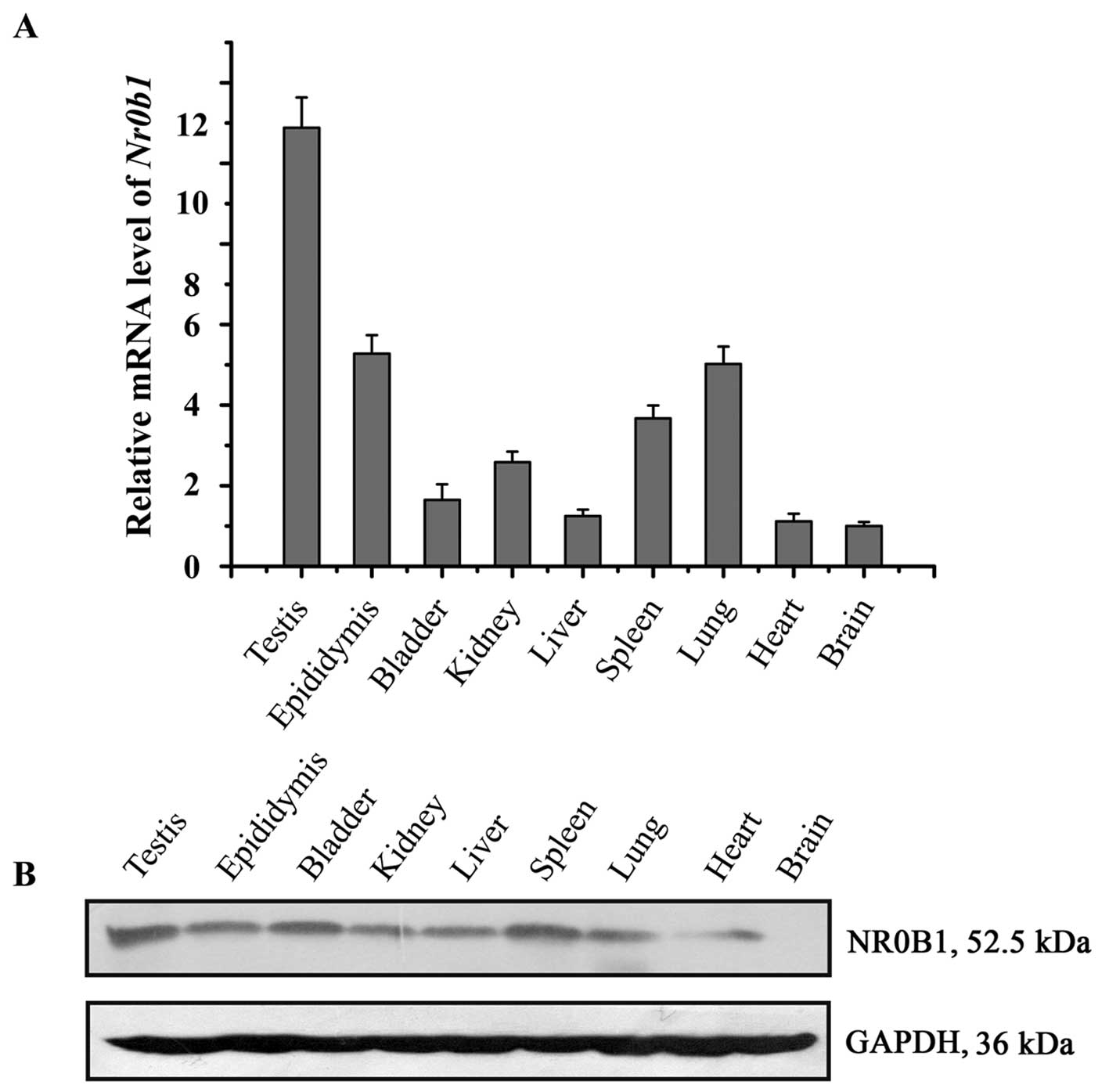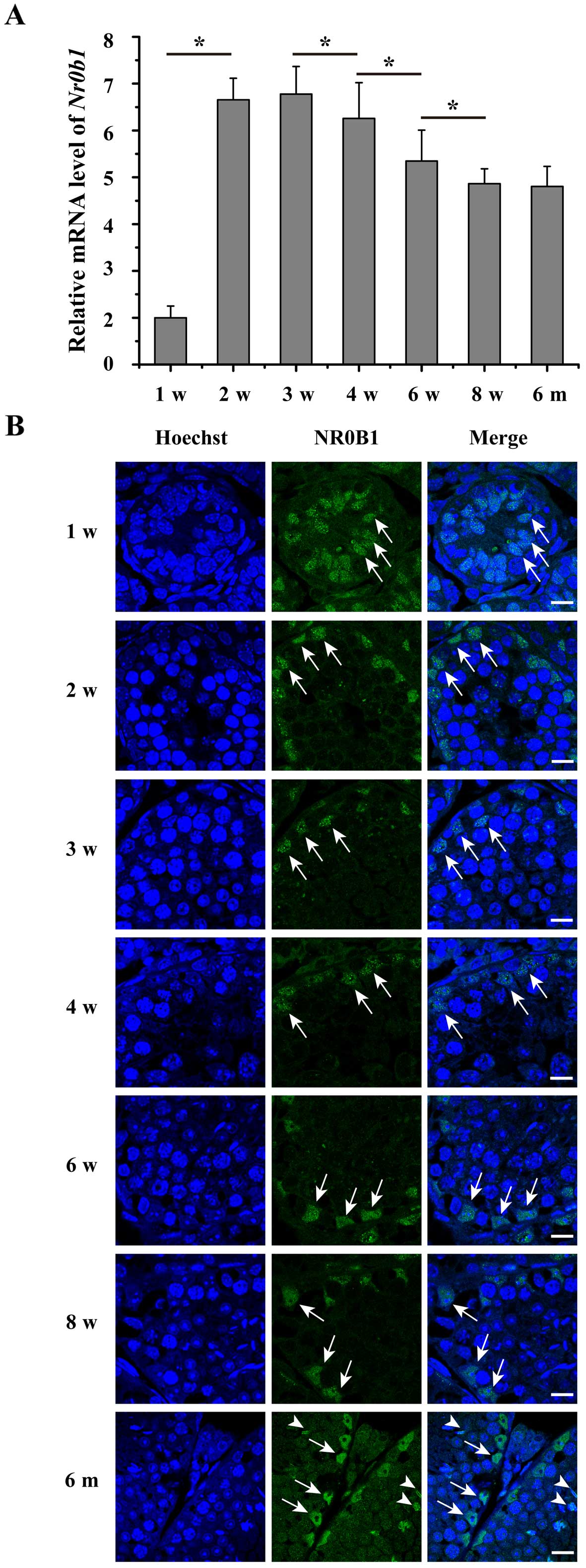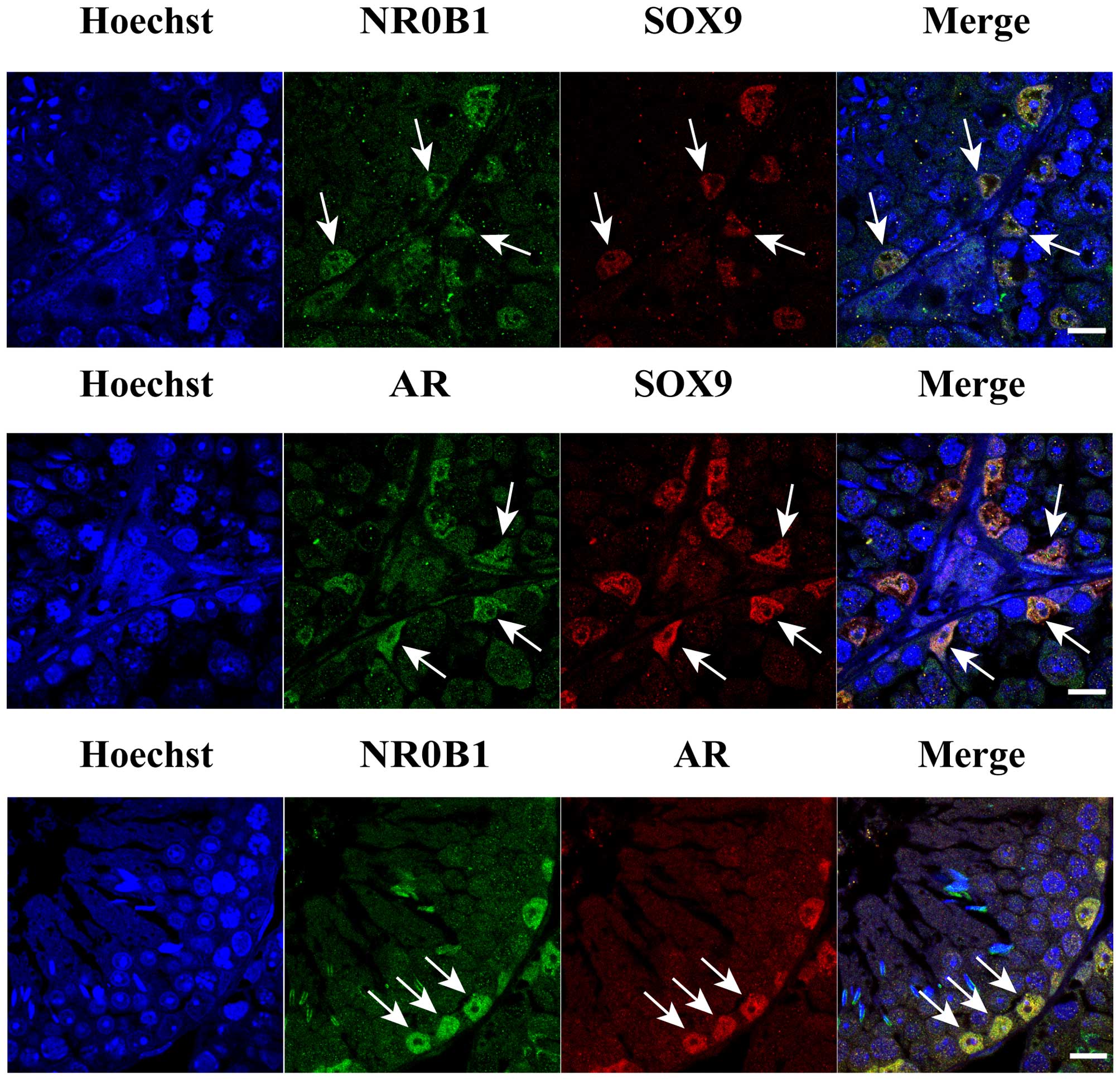|
1
|
Goto M and Katsumata N: X-linked adrenal
hypoplasia congenita caused by a novel intronic mutation of the
DAX-1 gene. Horm Res. 71:120–124. 2009. View Article : Google Scholar : PubMed/NCBI
|
|
2
|
Ikeda Y, Takeda Y, Shikayama T, Mukai T,
Hisano S and Morohashi KI: Comparative localization of Dax-1 and
Ad4BP/SF-1 during development of the hypothalamic-pituitary-gonadal
axis suggests their closely related and distinct functions. Dev
Dyn. 220:363–376. 2001. View Article : Google Scholar : PubMed/NCBI
|
|
3
|
Bardoni B, Zanaria E, Guioli S, Floridia
G, Worley KC, Tonini G, Ferrante E, Chiumello G, McCabe ER,
Fraccaro M, et al: A dosage sensitive locus at chromosome Xp21 is
involved in male to female sex reversal. Nat Genet. 7:497–501.
1994. View Article : Google Scholar : PubMed/NCBI
|
|
4
|
Achermann JC, Meeks JJ and Jameson JL:
Phenotypic spectrum of mutations in DAX-1 and SF-1. Mol Cell
Endocrinol. 185:17–25. 2001. View Article : Google Scholar : PubMed/NCBI
|
|
5
|
Yu RN, Ito M, Saunders TL, Camper SA and
Jameson JL: Role of Ahch in gonadal development and gametogenesis.
Nat Genet. 20:353–357. 1998. View
Article : Google Scholar : PubMed/NCBI
|
|
6
|
Jeffs B, Meeks JJ, Ito M, Martinson FA,
Matzuk MM, Jameson JL and Russell LD: Blockage of the rete testis
and efferent ductules by ectopic Sertoli and Leydig cells causes
infertility in Dax1-deficient male mice. Endocrinology.
142:4486–4495. 2001. View Article : Google Scholar : PubMed/NCBI
|
|
7
|
Heemers HV and Tindall DJ: Androgen
receptor (AR) coregulators: a diversity of functions converging on
and regulating the AR transcriptional complex. Endocr Rev.
28:778–808. 2007. View Article : Google Scholar : PubMed/NCBI
|
|
8
|
Heinlein CA and Chang C: Androgen receptor
(AR) coregulators: an overview. Endocr Rev. 23:175–200. 2002.
View Article : Google Scholar : PubMed/NCBI
|
|
9
|
Patrão MT, Silva EJ and Avellar MC:
Androgens and the male reproductive tract: an overview of classical
roles and current perspectives. Arq Bras Endocrinol Metabol.
53:934–945. 2009. View Article : Google Scholar
|
|
10
|
De Gendt K, Swinnen JV, Saunders PT,
Schoonjans L, Dewerchin M, Devos A, Tan K, Atanassova N, Claessens
F, Lécureuil C, et al: A Sertoli cell-selective knockout of the
androgen receptor causes spermatogenic arrest in meiosis. Proc Natl
Acad Sci USA. 101:1327–1332. 2004. View Article : Google Scholar : PubMed/NCBI
|
|
11
|
Wang RS, Yeh S, Tzeng CR and Chang C:
Androgen receptor roles in spermatogenesis and fertility: lessons
from testicular cell-specific androgen receptor knockout mice.
Endocr Rev. 30:119–132. 2009. View Article : Google Scholar : PubMed/NCBI
|
|
12
|
Yeh S, Tsai MY, Xu Q, Mu XM, Lardy H,
Huang KE, Lin H, Yeh SD, Altuwaijri S, Zhou X, et al: Generation
and characterization of androgen receptor knockout (ARKO) mice: an
in vivo model for the study of androgen functions in selective
tissues. Proc Natl Acad Sci USA. 99:13498–13503. 2002. View Article : Google Scholar : PubMed/NCBI
|
|
13
|
Quigley CA, De Bellis A, Marschke KB,
el-Awady MK, Wilson EM and French FS: Androgen receptor defects:
historical, clinical, and molecular perspectives. Endocr Rev.
16:271–321. 1995.PubMed/NCBI
|
|
14
|
Yong EL, Ghadessy F, Wang Q, Mifsud A and
Ng SC: Androgen receptor transactivation domain and control of
spermatogenesis. Rev Reprod. 3:141–144. 1998. View Article : Google Scholar
|
|
15
|
Culig Z, Hobisch A, Bartsch G and Klocker
H: Androgen receptor - an update of mechanisms of action in
prostate cancer. Urol Res. 28:211–219. 2000. View Article : Google Scholar : PubMed/NCBI
|
|
16
|
Hughes IA: Minireview: sex
differentiation. Endocrinology. 142:3281–3287. 2001. View Article : Google Scholar : PubMed/NCBI
|
|
17
|
Jänne OA, Moilanen AM, Poukka H, Rouleau
N, Karvonen U, Kotaja N, Häkli M and Palvimo JJ:
Androgen-receptor-interacting nuclear proteins. Biochem Soc Trans.
28:401–405. 2000. View Article : Google Scholar : PubMed/NCBI
|
|
18
|
Schmittgen TD and Livak KJ: Analyzing
real-time PCR data by the comparative C(T) method. Nat Protoc.
3:1101–1108. 2008. View Article : Google Scholar : PubMed/NCBI
|
|
19
|
Meeks JJ, Crawford SE, Russell TA,
Morohashi K, Weiss J and Jameson JL: Dax1 regulates testis cord
organization during gonadal differentiation. Development.
130:1029–1036. 2003. View Article : Google Scholar : PubMed/NCBI
|
|
20
|
Hanley NA, Hagan DM, Clement-Jones M, Ball
SG, Strachan T, Salas-Cortés L, McElreavey K, Lindsay S, Robson S,
Bullen P, et al: SRY, SOX9, and DAX1 expression patterns during
human sex determination and gonadal development. Mech Dev.
91:403–407. 2000. View Article : Google Scholar : PubMed/NCBI
|
|
21
|
Münsterberg A and Lovell-Badge R:
Expression of the mouse anti-müllerian hormone gene suggests a role
in both male and female sexual differentiation. Development.
113:613–624. 1991.
|
|
22
|
Kent J, Wheatley SC, Andrews JE, Sinclair
AH and Koopman P: A male-specific role for SOX9 in vertebrate sex
determination. Development. 122:2813–2822. 1996.PubMed/NCBI
|
|
23
|
Morais da Silva S, Hacker A, Harley V,
Goodfellow P, Swain A and Lovell-Badge R: Sox9 expression during
gonadal development implies a conserved role for the gene in testis
differentiation in mammals and birds. Nat Genet. 14:62–68. 1996.
View Article : Google Scholar : PubMed/NCBI
|
|
24
|
Denolet E, De Gendt K, Allemeersch J,
Engelen K, Marchal K, Van Hummelen P, Tan KA, Sharpe RM, Saunders
PT, Swinnen JV and Verhoeven G: The effect of a Sertoli
cell-selective knockout of the androgen receptor on testicular gene
expression in prepubertal mice. Mol Endocrinol. 20:321–334. 2006.
View Article : Google Scholar
|
|
25
|
De Gendt K, Denolet E, Willems A, Daniels
VW, Clinckemalie L, Denayer S, Wilkinson MF, Claessens F, Swinnen
JV and Verhoeven G: Expression of Tubb3, a beta-tubulin isotype, is
regulated by androgens in mouse and rat Sertoli cells. Biol Reprod.
85:934–945. 2011. View Article : Google Scholar : PubMed/NCBI
|
|
26
|
Zhou W, Wang G, Small CL, Liu Z, Weng CC,
Yang L, Griswold MD and Meistrich ML: Gene expression alterations
by conditional knockout of androgen receptor in adult Sertoli cells
of Utp14b jsd/jsd (jsd) mice. Biol Reprod. 84:400–408. 2011.
View Article : Google Scholar : PubMed/NCBI
|
|
27
|
Zhang QX, Zhang XY, Zhang ZM, Lu W, Liu L,
Li G, Cai ZM, Gui YT and Chang C: Identification of
testosterone-/androgen receptor-regulated genes in mouse Sertoli
cells. Asian J Androl. 14:294–300. 2012. View Article : Google Scholar
|
|
28
|
Eacker SM, Shima JE, Connolly CM, Sharma
M, Holdcraft RW, Griswold MD and Braun RE: Transcriptional
profiling of androgen receptor (AR) mutants suggests instructive
and permissive roles of AR signaling in germ cell development. Mol
Endocrinol. 21:895–907. 2007. View Article : Google Scholar : PubMed/NCBI
|
|
29
|
Yang L, Wang Y, Zhang Q, Lai Y, Li C,
Zhang Q, Huang W, Duan Y, Jiang Z, Li X, et al: Identification of
Hsf1 as a novel androgen receptor-regulated gene in mouse Sertoli
cells. Mol Reprod Dev. 81:514–523. 2014. View Article : Google Scholar : PubMed/NCBI
|
|
30
|
Mou L, Zhang Q, Wang Y, Zhang Q, Sun L, Li
C, Huang W, Yuan Y, Duan Y, Diao R, et al: Identification of Ube2b
as a novel target of androgen receptor in mouse sertoli cells. Biol
Reprod. 89:322013. View Article : Google Scholar : PubMed/NCBI
|
|
31
|
Burris TP, Guo W and McCabe ER: The gene
responsible for adrenal hypoplasia congenita, DAX-1, encodes a
nuclear hormone receptor that defines a new class within the
superfamily. Recent Prog Horm Res. 51:241–260. 1996.PubMed/NCBI
|
|
32
|
Giguère V: Orphan nuclear receptors: from
gene to function. Endocr Rev. 20:689–725. 1999.PubMed/NCBI
|
|
33
|
Iyer AK and McCabe ER: Molecular
mechanisms of DAX1 action. Mol Genet Metab. 83:60–73. 2004.
View Article : Google Scholar : PubMed/NCBI
|
|
34
|
Jeffs B, Ito M, Yu RN, Martinson FA, Wang
ZJ, Doglio LT and Jameson JL: Sertoli cell-specific rescue of
fertility, but not testicular pathology, in Dax1 (Ahch)-deficient
male mice. Endocrinology. 142:2481–2488. 2001.PubMed/NCBI
|
|
35
|
Kotaja N, Vihinen M, Palvimo JJ and Jänne
OA: Androgen receptor-interacting protein 3 and other PIAS proteins
cooperate with glucocorticoid receptor-interacting protein 1 in
steroid receptor-dependent signaling. J Biol Chem. 277:17781–17788.
2002. View Article : Google Scholar : PubMed/NCBI
|
|
36
|
Yu X, Li P, Roeder RG and Wang Z:
Inhibition of androgen receptor-mediated transcription by
amino-terminal enhancer of split. Mol Cell Biol. 21:4614–4625.
2001. View Article : Google Scholar : PubMed/NCBI
|
|
37
|
Reutens AT, Fu M, Wang C, Albanese C,
McPhaul MJ, Sun Z, Balk SP, Jänne OA, Palvimo JJ and Pestell RG:
Cyclin D1 binds the androgen receptor and regulates
hormone-dependent signaling in a p300/CBP-associated factor
(P/CAF)-dependent manner. Mol Endocrinol. 15:797–811. 2001.
View Article : Google Scholar : PubMed/NCBI
|
|
38
|
Hayes SA, Zarnegar M, Sharma M, Yang F,
Peehl DM, ten Dijke P and Sun Z: SMAD3 represses androgen
receptor-mediated transcription. Cancer Res. 61:2112–2118.
2001.PubMed/NCBI
|
|
39
|
Lin HK, Yeh S, Kang HY and Chang C: Akt
suppresses androgen-induced apoptosis by phosphorylating and
inhibiting androgen receptor. Proc Natl Acad Sci USA. 98:7200–7205.
2001. View Article : Google Scholar : PubMed/NCBI
|
|
40
|
Yang F, Li X, Sharma M, Zarnegar M, Lim B
and Sun Z: Androgen receptor specifically interacts with a novel
p21-activated kinase, PAK6. J Biol Chem. 276:15345–15353. 2001.
View Article : Google Scholar : PubMed/NCBI
|
|
41
|
Poukka H, Karvonen U, Janne OA and Palvimo
JJ: Covalent modification of the androgen receptor by small
ubiquitin-like modifier 1 (SUMO-1). Proc Natl Acad Sci USA.
97:14145–14150. 2000. View Article : Google Scholar : PubMed/NCBI
|
|
42
|
Zhang H, Thomsen JS, Johansson L,
Gustafsson JA and Treuter E: DAX-1 functions as an LXXLL-containing
corepressor for activated estrogen receptors. J Biol Chem.
275:39855–39859. 2000. View Article : Google Scholar : PubMed/NCBI
|
|
43
|
Ito M, Yu R and Jameson JL: DAX-1 inhibits
SF-1-mediated transactivation via a carboxy-terminal domain that is
deleted in adrenal hypoplasia congenita. Mol Cell Biol.
17:1476–1483. 1997. View Article : Google Scholar : PubMed/NCBI
|
|
44
|
Altincicek B, Tenbaum SP, Dressel U,
Thormeyer D, Renkawitz R and Baniahmad A: Interaction of the
corepressor Alien with DAX-1 is abrogated by mutations of DAX-1
involved in adrenal hypoplasia congenita. J Biol Chem.
275:7662–7667. 2000. View Article : Google Scholar : PubMed/NCBI
|
|
45
|
Crawford PA, Dorn C, Sadovsky Y and
Milbrandt J: Nuclear receptor DAX-1 recruits nuclear receptor
corepressor N-CoR to steroidogenic factor 1. Mol Cell Biol.
18:2949–2956. 1998. View Article : Google Scholar : PubMed/NCBI
|
|
46
|
Yong EL, Lim J, Qi W, Ong V and Mifsud A:
Molecular basis of androgen receptor diseases. Ann Med. 32:15–22.
2000. View Article : Google Scholar : PubMed/NCBI
|
|
47
|
Thompson J, Saatcioglu F, Jänne OA and
Palvimo JJ: Disrupted amino- and carboxyl-terminal interactions of
the androgen receptor are linked to androgen insensitivity. Mol
Endocrinol. 15:923–935. 2001. View Article : Google Scholar : PubMed/NCBI
|
|
48
|
Beilin J, Ball EM, Favaloro JM and Zajac
JD: Effect of the androgen receptor CAG repeat polymorphism on
transcriptional activity: Specificity in prostate and non-prostate
cell lines. J Mol Endocrinol. 25:85–96. 2000. View Article : Google Scholar : PubMed/NCBI
|
|
49
|
Slagsvold T, Kraus I, Bentzen T, Palvimo J
and Saatcioglu F: Mutational analysis of the androgen receptor AF-2
(activation function 2) core domain reveals functional and
mechanistic differences of conserved residues compared with other
nuclear receptors. Mol Endocrinol. 14:1603–1617. 2000. View Article : Google Scholar : PubMed/NCBI
|
|
50
|
Reutens AT, Achermann JC, Ito M, Ito M, Gu
WX, Habiby RL, Donohoue PA, Pang S, Hindmarsh PC and Jameson JL:
Clinical and functional effects of mutations in the DAX-1 gene in
patients with adrenal hypoplasia congenita. J Clin Endocrinol
Metab. 84:504–511. 1999.PubMed/NCBI
|
|
51
|
Muscatelli F, Strom TM, Walker AP, Zanaria
E, Récan D, Meindl A, Bardoni B, Guioli S, Zehetner G, Rabl W, et
al: Mutations in the DAX-1 gene give rise to both X-linked adrenal
hypoplasia congenita and hypogonadotropic hypogonadism. Nature.
372:672–676. 1994. View Article : Google Scholar : PubMed/NCBI
|
|
52
|
Lalli E, Bardoni B, Zazopoulos E, Wurtz
JM, Strom TM, Moras D and Sassone-Corsi P: A transcriptional
silencing domain in DAX-1 whose mutation causes adrenal hypoplasia
congenita. Mol Endocrinol. 11:1950–1960. 1997. View Article : Google Scholar
|
|
53
|
Achermann JC and Jameson JL: Fertility and
infertility: genetic contributions from the
hypothalamic-pituitary-gonadal axis. Mol Endocrinol. 13:812–818.
1999. View Article : Google Scholar : PubMed/NCBI
|















